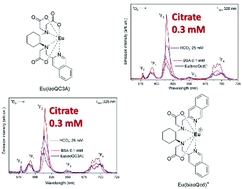Isoquinoline-based Eu(iii) luminescent probes for citrate sensing in complex matrix†
Abstract
A neutral Eu(III) complex containing the S,S enantiomer of isoQC3A3− ligand (isoQC3A3− = N-isoquinolyl-N,N′,N′-trans-l,2-cyclohexylenediaminetriacetate) was synthesized and characterized. The complex was spectroscopically investigated and the results compared with those obtained for the similar bis-anionic ligand bisoQcd2− (bisoQcd2− = N,N′-bis(2-isoquinolinmethyl)-trans-1,2-diaminocyclohexane N,N′-diacetate). Both Eu(III)-complexes show similar binding constants upon titration with the main analytes contained in interstitial extracellular fluid (i.e. hydrogen carbonate, serum albumin and citrate). However, the analyte affinity is accompanied by different enhancements of the Eu(III) intrinsic quantum yield (QY). Structures and hydration numbers of the complexes are determined by luminescence decay measurements and DFT calculations. The QYs as well as the binding constants of the individual adducts of the complexes with hydrogen carbonate, bovine serum albumin (BSA) and citrate are determined. The study of the Eu(III) emission upon the systematic variation of one analyte in a complex mixture has been carried out to predict the performance of the luminescent sensor in conditions close to the real extracellular environment. Both Eu(III) complexes can detect citrate at extracellular concentrations up to 500 μM, even at millimolar concentrations of the other interfering species. In the case of the Eu(bisoQcd)OTf complex, an increase of 23% of the Eu(III) luminescence intensity at 615 nm upon addition of 0.3 mM of citrate was recorded. This feature makes the latter complex a viable probe for luminescence analysis of citrate in a complex matrix.



 Please wait while we load your content...
Please wait while we load your content...